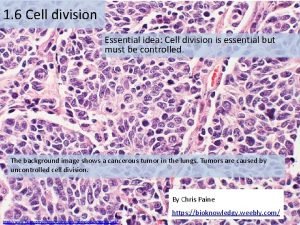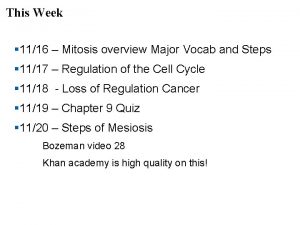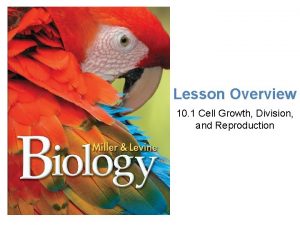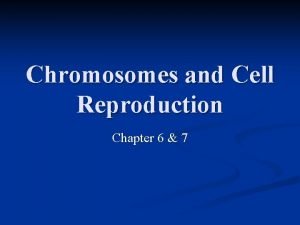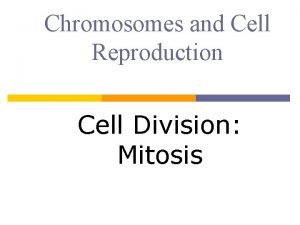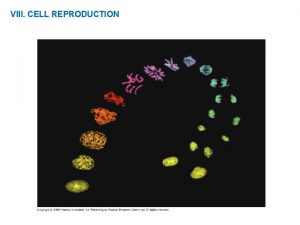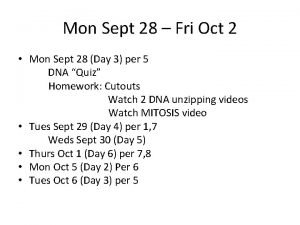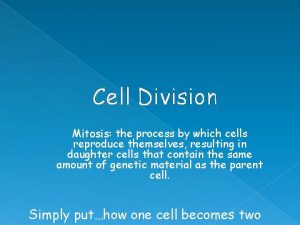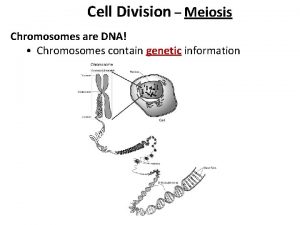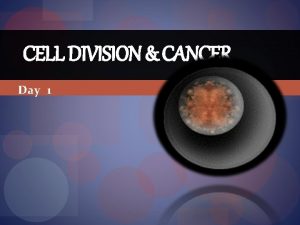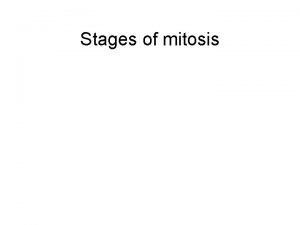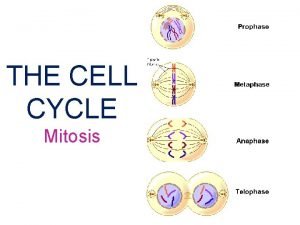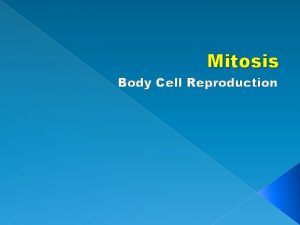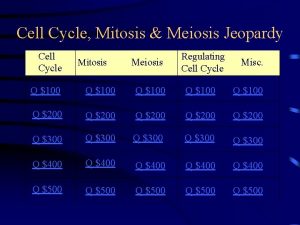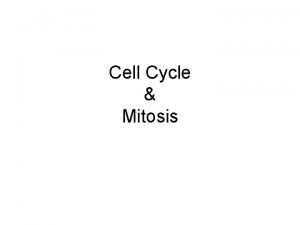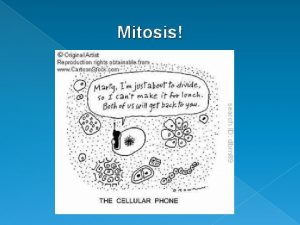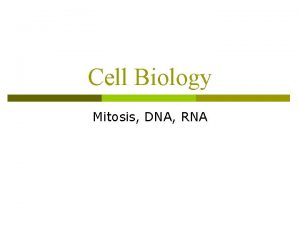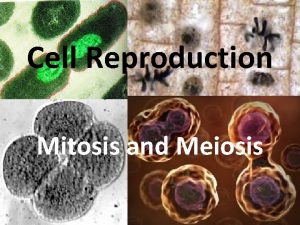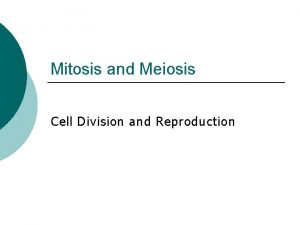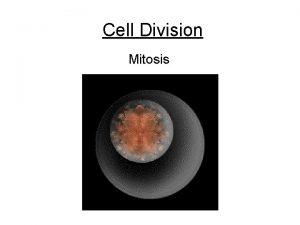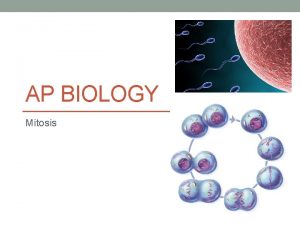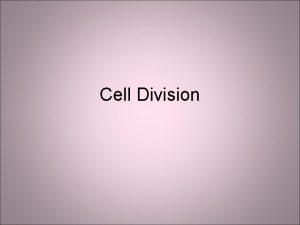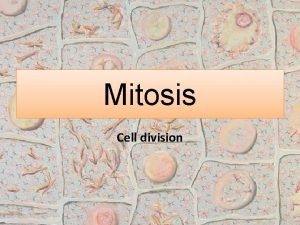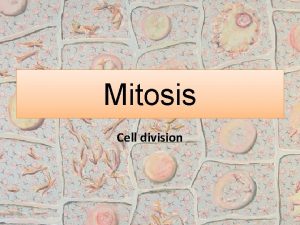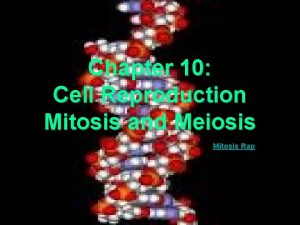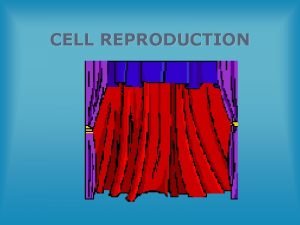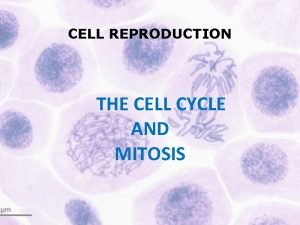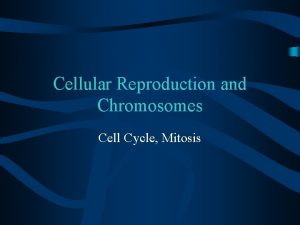CELL REPRODUCTION THE CELL CYCLE AND MITOSIS CELL

























- Slides: 25

CELL REPRODUCTION THE CELL CYCLE AND MITOSIS

CELL REPRODUCTION • Cell Division: process by which a cell divides to form two new cells (daughter cells) • Three types of cell division, or cell reproduction – Prokaryotes (bacteria) • Binary fission divides forming two new identical cells – Eukaryotes • Mitosis – Cell or organism growth – Replacement or repair of damaged cells • Meiosis – formation of sex cells, or gametes

Why do cells divide? 1: DNA Overload – If cells grow without limit, an “information crisis” would develop – DNA cannot serve the needs of the increasing size of cell 2: Exchange of materials – Food and oxygen have to cross membrane very quickly – Waste must get out – If cell is too large, this occurs too slowly and cell will die

PROKARYOTIC CELL DIVISION • Binary fission – 3 main steps: 1: DNA Replication—DNA is copied, resulting in 2 identical chromosomes 2: Chromosome Segregation— 2 chromosomes separate, move towards ends (poles) of cell 3: Cytokinesis—cytoplasm divides, forming 2 cells – Each new daughter cell is genetically identical to parent cell

I. Bacterial Cell Division • • Cell Growth and Binary Fission Fts Proteins and Cell Division Mre. B and Determinants of Cell Morphology Peptidoglycan Synthesis and Cell Division

Cell Growth and Binary Fission • Binary fission: cell division following enlargement of a cell to twice its minimum size • Generation time: time required for microbial cells to double in number • During cell division, each daughter cell receives a chromosome and sufficient copies of all other cell constituents to exist as an independent cell

One generation Cell elongation Septum formation Completion of septum; formation of walls; cell separation

Fts Proteins and Cell Division • Fts (filamentous temperature-sensitive) Proteins – Essential for cell division in all prokaryotes – Interact to form the divisome (cell division apparatus) • Fts. Z: forms ring around center of cell; related to tubulin • Zip. A: anchor that connects Fts. Z ring to cytoplasmic membrane • Fts. A: helps connect Fts. Z ring to membrane and also recruits other divisome proteins – Related to actin

Fts Proteins and Cell Division • DNA replicates before the Fts. Z ring forms • Location of Fts. Z ring is facilitated by Min proteins – Min. C, Min. D, Min. E • Fts. K protein mediates separation of chromosomes to daughter cells

Outer membrane Peptidoglycan Cytoplasmic membrane Divisome complex Cytoplasmic membrane Fts. Z ring

Mre. B and Determinants of Cell Morphology • Prokaryotes contain a cell cytoskeleton that is dynamic and multifaceted • Mre. B: major shape-determining factor in prokaryotes – Forms simple cytoskeleton in Bacteria and probably Archaea – Forms spiral-shaped bands around the inside of the cell, underneath the cytoplasmic membrane – Not found in coccus-shaped bacteria

Mre. B and Determinants of Cell Morphology • Mre. B (cont’d) – Localizes synthesis of new peptidoglycan and other cell wall components to specific locations along the cylinder of a rod-shaped cell during growth

Figure 5. 4 a Fts. Z Cell wall Cytoplasmic membrane Mre. B Sites of cell wall synthesis

Figure 5. 4 b

Mre. B and Determinants of Cell Morphology • Most archaeal genomes contain Fts. Z and Mre. Blike proteins, thus cell morphology is similar to that seen in Bacteria

Peptidoglycan Synthesis and Cell Division • Production of new cell wall material is a major feature of cell division – In cocci, cell walls grow in opposite directions outward from the Fts. Z ring – In rod-shaped cells, growth occurs at several points along length of the cell

Peptidoglycan Synthesis and Cell Division • Preexisting peptidoglycan needs to be severed to allow newly synthesized peptidoglycan to form – Beginning at the Fts. Z ring, small openings in the wall are created by autolysins – New cell wall material is added across the openings – Wall band: junction between new and old peptidoglycan

Figure 5. 5 Fts. Z ring Wall bands Septum © 2012 Pearson Education, Inc. Growth zone

Figure 5. 4 a Fts. Z Cell wall Cytoplasmic membrane Mre. B Sites of cell wall synthesis © 2012 Pearson Education, Inc.

Peptidoglycan Synthesis and Cell Division • Bactoprenol: carrier molecule that plays major role in insertion of peptidoglycan precursors – C 55 alcohol – Bonds to N-acetylglucosamine/ N-acetylmuramic acid/pentapeptide peptidoglycan precursor © 2012 Pearson Education, Inc.

Peptidoglycan Synthesis and Cell Division • Glycolases: enzymes that interact with bactoprenol – Insert cell wall precursors into growing points of cell wall – Catalyze glycosidic bond formation © 2012 Pearson Education, Inc.

Figure 5. 7 a Peptidoglycan Transglycosylase activity Cytoplasmic membrane Out Growing point of cell wall Autolysin activity In Pentapeptide Bactoprenol © 2012 Pearson Education, Inc.

Peptidoglycan Synthesis and Cell Division • Transpeptidation: final step in cell wall synthesis – Forms the peptide cross-links between muramic acid residues in adjacent glycan chains – Inhibited by the antibiotic penicillin © 2012 Pearson Education, Inc.

Figure 5. 7 b Transpeptidation © 2012 Pearson Education, Inc.

 Hare lynx
Hare lynx Essential idea
Essential idea Mitosis
Mitosis Binary fission in bacteria
Binary fission in bacteria Venn diagram of asexual and sexual
Venn diagram of asexual and sexual Steps of cell cycle
Steps of cell cycle Mitosis sexual reproduction
Mitosis sexual reproduction Bioflix activity: mitosis -- events of mitosis
Bioflix activity: mitosis -- events of mitosis Events of the cell cycle
Events of the cell cycle Cell cycle and cell division
Cell cycle and cell division Cell growth division and reproduction
Cell growth division and reproduction Chapter 6 chromosomes and cell reproduction
Chapter 6 chromosomes and cell reproduction Cell division mitosis and meiosis
Cell division mitosis and meiosis Cell division mitosis and meiosis
Cell division mitosis and meiosis Biology.arizona.edu/cell bio/activities/cell cycle/01.html
Biology.arizona.edu/cell bio/activities/cell cycle/01.html Cell reproduction
Cell reproduction Cell of reproduction
Cell of reproduction Cell reproduction
Cell reproduction 2 mon
2 mon How do you know
How do you know Number of chromosomes in meiosis
Number of chromosomes in meiosis Cell mitosis
Cell mitosis What phase
What phase Mitosis cytokinesis
Mitosis cytokinesis Bone cells mitosis
Bone cells mitosis Mitosis bingo
Mitosis bingo

